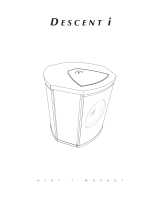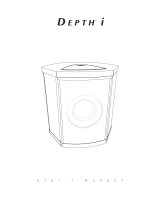
SUB 560P
400-Watt, 12" (300mm) Powered Subwoofer
OWNER’S MANUAL

2
Included Items
1X
1X
1X
usInG tHe suPPlIed sPIKes
Four metal spikes are supplied for use when you place the subwoofer
on a carpeted surface. Using the spikes decouples the subwoofer from
the floor and prevents unwanted acoustic damping.
TO INSERT THE SPIKES:
1. Gently turn the subwoofer upside down on a soft, nonabrasive
surface.
2. Unscrew and remove the rubber bumpers from the subwoofer’s feet.
3. Screw each spike into the threaded insert in each foot. Make sure all
four spikes are screwed in completely for stability.
NOTE: NEVER drag the subwoofer to move it, as this will damage
the spikes, the feet and/or the subwoofer cabinet itself. Always
lift the subwoofer and carry it to its new location.
tHanK You For cHoosInG tHIs JBl
®
Product
Your new JBL
®
SUB 560P 400-watt powered subwoofer incorporates a 12" (300mm) forward-firing cone transducer and a built-in high-performance
400-watt RMS amplifier that deliver the powerful, dynamic and accurate low-frequency performance that makes your film soundtracks and music
come alive. And with line-level and LFE inputs, adjustable crossover and phase controls and automatic turn on/off, the SUB 560P is also simple to
connect and set up.
We’re confident that this JBL subwoofer will provide every note of enjoyment that you expect – and that when you think about purchasing additional
audio equipment for your home, car or office, you will once again choose JBL products.
This owner’s manual contains all the information you need to set up, connect and adjust your new subwoofer. For even more in-depth information,
go to our Web site: www.jbl.com.
CAUTION
To prevent electric shock
hazard replace grille
IMPORTANT: This subwoofer requires proper ventilation and is not to be used in an enclosed environment.

3
www.jbl.com
English
suBwooFer rear-Panel controls and connectIons
Input Mode switch: This switch determines if the input signal passes
through the subwoofer’s built-in low-pass crossover network.
• If you are connecting the subwoofer to a source device that does not
have its own crossover network (such as a stereo preamp), set the
switch in the “Normal” position. The input signal will pass through
the subwoofer’s built-in crossover network.
• If you are connecting the subwoofer to a source device that does
have its own crossover network (such as an audio/video receiver
with built-in bass management), set this switch in the “LFE” position.
The input signal will bypass the subwoofer’s built-in crossover
network.
Phase switch: This switch determines whether the subwoofer driver’s
piston-like action moves in and out in phase with the system’s other
speakers. If the subwoofer were to play out of phase with the other
speakers, the sound waves from the other speakers could partially
cancel out the sound waves from the subwoofer, reducing bass
performance and sonic impact. This phenomenon depends in part on
the placement of all the speakers relative to each other in the room.
Crossover control: This control determines the highest frequency
at which the subwoofer reproduces sounds. The higher you set
the Crossover control, the higher in frequency the subwoofer will
operate and the more its bass will “overlap” that of the system’s other
speakers. This adjustment helps achieve a smooth transition of bass
frequencies between the subwoofer and the other speakers for a variety
of different rooms and subwoofer locations. NOTE: The Crossover
control functions only when the Input Mode switch is in the
“Normal” position. When the switch is in the “LFE” position
the subwoofer’s built-in crossover and Crossover control are
bypassed.
Level control: Use this control to adjust the subwoofer’s volume.
Turn the knob clockwise to increase the volume; turn the knob
counterclockwise to decrease the volume.
Line In connectors: Connect your source device to these connectors.
• When you’re connecting the subwoofer to the preamp or subwoofer
outputs of a receiver/processor that does not have its own low-pass
crossover network, use both Line In connectors and set the Input
Mode switch in the “Normal” position.
• When you’re connecting the subwoofer to the dedicated subwoofer
output of a receiver/processor that has its own low-pass crossover
network, use either Line In connector and set the Input Mode switch
in the “LFE” position.
On/Standby indicator: This LED indicates whether the subwoofer is in
the On or Standby state:
• When the LED glows green, the subwoofer is turned on.
• When the LED glows red, the subwoofer is in the Standby mode.
• When the LED is off, the subwoofer’s Power switch is set to “Off.”
Power switch: Set this switch in the “On” position to put the
subwoofer in the Standby mode (the On/Standby LED lights red); set
this switch in the “Off” position to turn the subwoofer off.
Power cord: After you have made and verified all subwoofer
connections described in this manual, plug the power cord into
an active, unswitched electrical outlet for proper operation of the
subwoofer. DO NOT plug this cord into the accessory outlet found on
some audio components.
Level Control
Crossover Control
On/Standby
Indicator
Phase Switch
Input Mode Switch
Line In
Connectors
Power Switch
Power Cord

4
PLAciNg thE SUBWOOfER
The performance of a subwoofer is directly related to its placement
in the listening room and its physical position relative to the other
speakers in the system.
While it is true that in general our ears do not hear directional sounds
at the low frequencies where subwoofers operate, when installing
a subwoofer within the limited confines of a room, the reflections,
standing waves and absorptions generated within the room will strongly
influence the performance of any subwoofer system. As a result, the
specific location of the subwoofer in the room does become important
to the amount and quality of bass that is produced.
For example, placing the subwoofer next to a wall generally will increase
the amount of bass in the room; placing it in a corner (1) generally will
maximize the amount of bass in the room. However, corner placement
can also increase the destructive effect of standing waves on bass
performance. This effect can vary depending on the listening position –
some listening positions may yield very good results while others may
have far too much (or too little) bass at certain frequencies.
In many rooms, placing the subwoofer along the same plane as the
left and right speakers (2) can produce the best integration between
the sound of the subwoofer and that of the left and right speakers. In
some rooms, the best performance could even result from placing the
subwoofer behind the listening position (3).
We strongly recommend that you experiment with placement before
choosing a nal location for your subwoofer. One way you can determine
the best location for the subwoofer is by temporarily placing it in the listening
position and playing music with strong bass content. Move around to various
locations in the room while the system is playing (putting your ears where the
subwoofer would be placed), and listen until you nd the location where the
bass performance is best. Place the subwoofer in that location.
Front
Left
Speaker
TV
Center Speaker Front
Right
Speaker
Surround
Left
Speaker
Surround
Right
Speaker
1.
2.
3.
connectInG tHe suBwooFer
TO A RECEIVER OR PREAMP/PROCESSOR WITH A LOW-PASS
FILTERED DEDICATED SUBWOOFER OUTPUT
Input Mode Switch
in “LFE” Position
Use Either
Connector
Receiver or
Amplifier
SUB 560P
Subwoofer
Mono
RCA Cable
(not supplied)
TO A RECEIVER OR PREAMP/PROCESSOR WITH LINE OUTPUTS
SUB 560P
Subwoofer
Stereo
RCA Cable
(not supplied)
Input Mode Switch
in “Normal” Position
Receiver or
Amplifier

5
www.jbl.com
English
oPeratInG tHe suBwooFer
TURNING THE SUBWOOFER ON AND OFF
Set the subwoofer’s Power switch to the “On” position. The subwoofer
will automatically turn itself on when it receives an audio signal, and it
will go into Standby mode after it has received no audio signal for 20
minutes. The subwoofer’s On/Standby LED will glow green when the
subwoofer is on and will glow red when the subwoofer is in Standby.
If you will not be using the subwoofer for an extended period – for
instance, if you’re going on vacation – set the Power switch to the “Off”
position.
SUBWOOFER ADJUSTMENTS: CROSSOVER CONTROL
NOTE: The Crossover control functions only
when you are using the Line In connectors and
the Input Mode switch is set to “Normal.” Setting
the Input Mode switch to “LFE” bypasses the
subwoofer’s built-in crossover and the Crossover
control.
The Crossover control adjusts the subwoofer’s built-
in crossover between 50Hz and 150Hz. The higher
you set the Crossover control, the higher in frequency the subwoofer
will operate and the more its bass will “overlap” that of the satellite
speakers. This adjustment helps achieve a smooth transition of bass
frequencies between the subwoofer and the satellites for a variety of
different rooms and subwoofer locations.
To set the Crossover control, listen for the smoothness of the bass. If
the bass seems too strong at certain frequencies, try a lower Crossover
control setting. If the bass seems too weak at certain frequencies, try a
higher Crossover control setting.
SUBWOOFER ADJUSTMENTS: VOLUME
Use the Level control to set the subwoofer’s volume.
Turn the knob clockwise to increase the subwoofer’s
volume; turn the knob counterclockwise to decrease
the volume. Once you have balanced the subwoofer’s
volume with that of the other speakers in your system,
you shouldn’t have to change it.
Notes on Setting Subwoofer Volume:
• Sometimes the ideal subwoofer volume setting for music is too loud
for films, while the ideal setting for films is too quiet for music. When
setting the subwoofer volume, listen to both music and films with
strong bass content and find a “middle ground” volume level that
works for both.
• I f your subwoofer always seems too loud or too quiet, you may want
to place it in a different location. Placing the subwoofer in a corner
will tend to increase its bass output, while placing it away from any
walls or corners will tend to lessen its bass output.
SUBWOOFER ADJUSTMENTS: PHASE
The Phase switch determines whether the subwoofer
driver’s piston-like action moves in and out in phase with
the system’s other speakers. If the subwoofer were to play
out of phase with the other speakers, the sound waves
from the satellites could partially cancel out the waves
from the subwoofer, reducing bass performance and
sonic impact. This phenomenon depends in part on the
placement of all the speakers relative to each other in the room.
Although in most cases you should leave the Phase switch in the “0”
position, there is no absolutely correct setting for the Phase switch.
When the subwoofer is properly in phase with the rest of the system’s
speakers, the sound will be clearer and have maximum impact, and
percussive sounds like drums, piano and plucked strings will sound
more lifelike. The best way to set the Phase switch is to listen to music
that you know well and to set the switch in the position that gives
drums and other percussive sounds maximum impact.
sPecIFIcatIons
Low-frequency
transducer:
12" (300mm) PolyPlas™ cone,
cast basket
Enclosure type: Sealed (forward-firing)
Amplifier power: 400W RMS; 600W peak
Frequency response: 22Hz – 150Hz
Audio controls: Volume level, crossover frequency, phase
Connections: RCA line-level and LFE inputs
Power requirement: 120V, 60Hz (US); 220V – 230V, 50Hz/60Hz
(EU)
Power consumption: <0.55W (120V & 230V) standby;
700W – 7.2A (120V),
700W – 3.6A (230V) maximum
Dimensions (W x H x D): 15-21/32" x 19-17/32" x 15-15/16"
(398mm x 496mm x 405mm)
Weight: 63 lb (29kg)
HARMAN International Industries, Incorporated
8500 Balboa Boulevard, Northridge, CA 91329 USA
© 2012 HARMAN International Industries, Incorporated. All rights reserved.
JBL is a trademark of HARMAN International Industries, Incorporated, registered in the United States
and/or other countries. PolyPlas is a trademark of HARMAN International Industries, Incorporated.
Features, specifications and appearance are subject to change without notice.
Part #: JBLP4685 Rev: A
-
 1
1
-
 2
2
-
 3
3
-
 4
4
-
 5
5
Ask a question and I''ll find the answer in the document
Finding information in a document is now easier with AI
Related papers
Other documents
-
Infinity SUB R12 Owner's manual
-
Harman Kardon HKTS 200 Owner's manual
-
Harman Kardon Cen-TS60 Owner's manual
-
Harman/Kardon SB 10 Specification
-
 MartinLogan Descent i User manual
MartinLogan Descent i User manual
-
Infinity PSW310W User manual
-
 MartinLogan GROTTO User manual
MartinLogan GROTTO User manual
-
 MartinLogan Depth i User manual
MartinLogan Depth i User manual
-
Infinity CASCADE TWELVE Owner's manual
-
Infinity PSW310W Owner's manual







